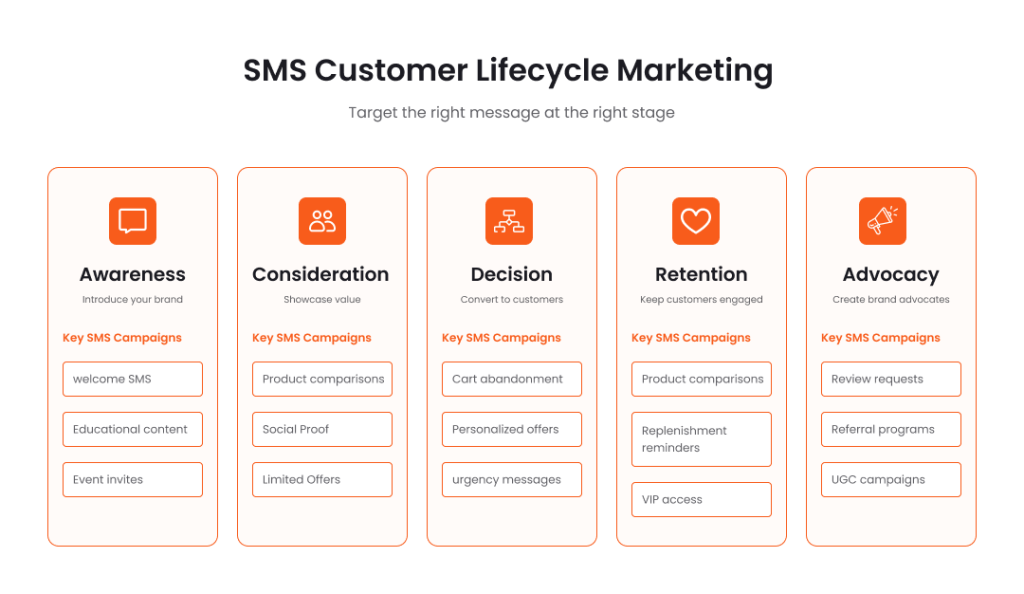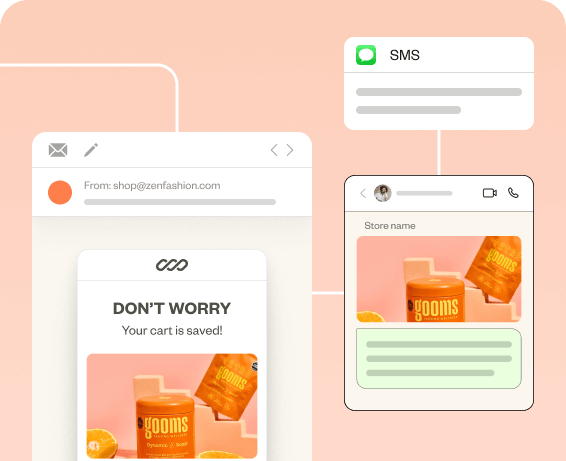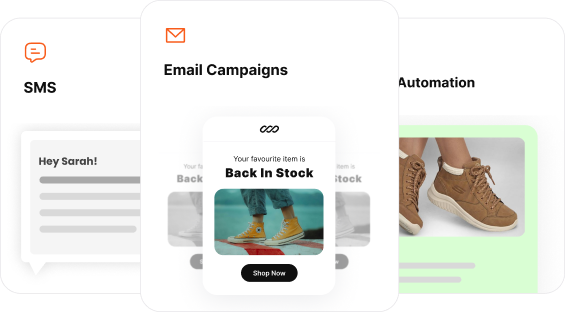SMS marketing strategies are no longer just about blasting out coupon codes or last-minute sales, they are the secret behind some of the most successful, high-converting digital campaigns today.
But here’s the catch: it’s not enough to simply send a text. To utilize SMS as more than just a communication channel, you must execute effective SMS marketing best practices such as personalization and timing. This enables SMS to become a revenue driver, a loyalty builder, and a customer experience enhancer.
So let’s dive in and learn the high-converting SMS marketing strategies you can start using right away.
Do ecommerce SMS marketing with Retainful and drive repeat sales.
11 Best SMS Marketing Strategies
SMS marketing strategies that actually work aren’t about blasting offers. They are about timing, relevance, and value. Nail these, and you’ll turn texts into your highest-converting channel.
Here are the 11 best SMS marketing strategies:
- Use Behavioral Triggers, Not Just Schedules
- Use SMS for more than promotions
- Respect Frequency and Compliance
- Leverage Two-Way Messaging
- Send Abandoned Cart Recovery Sequences
- Run Flash Sales with Countdown Urgency
- Segment Based on Engagement Levels
- Customer Lifecycle Nurturing
- Promote Back-in-Stock or Low Inventory Alerts
- Use SMS for Order Updates & Tracking
- Build Automated Drip Campaigns
Let’s see how to implement these strategies for SMS marketing in detail.
1. Use Behavioral Triggers, Not Just Schedules
Many marketers default to scheduled blasts, but timing SMS marketing messages based on behavior delivers far better results.
For example, if a user abandons their cart, sending a message within 30 minutes is more impactful than a general reminder the next day.
Here is an example of the best SMS marketing message.
“Hey Sarah! You left something behind. Complete your order in the next 2 hours and get 10% off: [link]”
2. Use SMS for more than promotions
Treating SMS marketing purely as a promotional channel risks annoying customers and missing out on the rich opportunities SMS provides for engagement, relationship building, and brand loyalty.
Most beginner marketers use SMS only to announce sales. But SMS campaigns are also great for support, feedback, storytelling, and customer retention.
Here are some SMS marketing campaigns that increases customer retention:
- Order confirmation & thank you messages
- Product usage tips and tutorials
- Customer feedback and satisfaction surveys
- Milestone celebrations (e.g., anniversaries, birthdays)
- Customer support and help desk outreach
- Restock notifications for favorite products
- Re-engagement check-ins for inactive customers
3. Respect Frequency and Compliance
One of the fastest ways to destroy your SMS list is by sending too often or ignoring compliance rules.
Sending SMS too often leads to customer fatigue, high opt-out rates, and even legal trouble. Compliance with regulations like the TCPA in the U.S., GDPR in Europe, and similar laws worldwide is mandatory.
Here are some SMS marketing tips to follow:
- 2 – 4 messages per month is safe; test before increasing frequency
- Always include opt-out instructions: “Reply STOP to unsubscribe.”
- Don’t send messages outside 8 AM – 9 PM recipient’s local time.
- Send fewer messages to less engaged users to avoid annoying them.
4. Leverage Two-Way Messaging
Instead of one-way broadcasts, a high-converting SMS marketing strategy is to encourage replies to create conversation and engagement.
Example: “Want early access to our Black Friday deals? Reply YES.” “You’re in! We’ll text you 24 hours before everyone else.”
5. Send Abandoned Cart Recovery Sequences
The best SMS ecommerce marketing strategy is to create a multi-touch SMS automation sequence that re-engages customers who added items to their cart but didn’t complete the purchase.
Here is an example abandoned cart recovery SMS sequence:
- Message 1 (1 hour after abandonment): Friendly reminder with product mention and direct cart link.
- Message 2 (24 hours later): Offer a small incentive (e.g., 10% off) to encourage purchase.
- Message 3 (48 hours later): Create urgency (“Last chance”) and remind about limited stock or discount expiration.
Strategies for nailing the abandoned cart SMS sequence are:
- Space messages strategically: 1 hour, 24 hours, then 72 hours works for most industries.
- Track which message in the sequence drives the most conversions and optimize accordingly.
- Use different messaging angles: urgency, social proof, value proposition.
- Create separate sequences for high-value vs. low-value abandoned carts.
Learn more about abandoned cart recovery:
6. Run Flash Sales with Countdown Urgency
A good SMS marketing automation strategy is to run flash sales that tap into FOMO (fear of missing out) and urgency, two powerful psychological triggers in marketing.
SMS marketing is the ideal channel because of its immediacy. People check their phones within minutes of receiving a text, making it the perfect delivery method for limited-time offers.
How to implement:
- Schedule your flash sale during peak engagement hours (e.g., lunchtime or early evening).
- Keep the message short and punchy.
- Use emojis or bold language to emphasize the urgency.
7. Segment Based on Engagement Levels
Not every subscriber interacts in the same way. Some engage with every message, while others are cold or dormant. Segmenting customers based on engagement helps you send more relevant content and avoid unsubscribes.
How to implement:
- Identify active users (clicked/opened/purchased in the last 30 days).
- Identify lapsed users (no interaction for 60+ days).
- Craft tailored messages for each segment.
Examples:
To engaged users
“You’re one of our top insiders. Here’s 20% off your next purchase – just because: [link]”
To inactive users:
“We miss you! Here’s 15% off to bring you back. Use code COMEBACK15 before Sunday: [link]”
8. Engage throughout the customer lifecycle
The best SMS marketing automation strategy is to create a series of SMS messages that guide customers through different stages of their lifecycle with your brand.
By tailoring your SMS campaigns to each lifecycle stage, you deliver timely, relevant messages that nurture leads, close sales, and foster loyalty – all while keeping your brand top-of-mind.

Here are example SMS campaigns to send at each stage:
- Awareness Stage: Welcome message campaign, First-purchase offer
- Consideration Stage: Product education series, customer testimonials highlight
- Decision Stage: Abandoned Cart Reminder, Limited-Time Discount Alert
- Retention Stage: Personalized Product Recommendations, Loyalty Rewards Notification
- Advocacy Stage: Referral Program Invitation, Review, and Feedback Request
9. Promote Back-in-Stock or Low Inventory Alerts
Nothing drives urgency like scarcity. Back-in-stock alerts make customers feel prioritized, and low-stock notices tap into FOMO. These messages are high-conversion because the recipient has already shown interest.
How to implement:
- Collect waitlist signups via SMS keyword (e.g., “Text NOTIFY to 12345”).
- Send alerts as soon as inventory is updated.
- Include a direct link to purchase.
10. Use SMS for Order Updates & Tracking
Sending order confirmation and delivery tracking SMS messages creates a smooth post-purchase experience that reduces customer anxiety and support requests. These transactional messages have high open rates and improve overall customer satisfaction.
How to implement this SMS marketing strategy:
- Integrate your SMS platform with your order management system.
- Trigger texts for order placement, shipping, and delivery.
- Include customer name, product names, or expected delivery times to add a personal touch.
11. Build Automated SMS Drip Campaigns
Automated drip campaigns send a series of timed SMS messages based on user behavior or time intervals. This SMS marketing automation strategy keeps your brand top-of-mind, nurtures leads, and guides customers through the sales funnel without manual effort. To improve the accuracy of these campaigns, using a voip number checker helps validate contact lists, filter out inactive or fraudulent numbers, and ensure messages reach real recipients.
How to implement:
- Use your SMS platform to set up automated flows.
- Start with a welcome message, followed by product highlights, social proof, and time-sensitive offers.
- Space out messages (e.g., Day 1, Day 3, Day 7) to avoid fatigue.
Examples
- Welcome Drip: Day 1 – Welcome message + discount; Day 3 – Brand story or top products; Day 7 – Reminder to use discount.
- Abandoned Cart Drip: 1 hour after cart abandonment – “Still thinking it over?”; 24 hours later – “Get 10% off your cart if you order today!”
- Re-engagement Drip: Target users inactive for 60 days with a series of messages offering incentives and new product announcements.
Related Reading:
Learn how to create automated email drip campaign easily:
Automate SMS marketing campaigns for every customer life-cycle stage with Retainful.
Wrapping up!!
Implementing SMS marketing strategies isn’t about sending more texts it’s about sending smarter ones.
Start small, focus on relevance, and respect your audience’s time. Test different messages, track what works, and double down on those wins. SMS marketing automation strategies like personalization and timing are your best friends here use data to tailor your approach at every lifecycle stage.
Remember, SMS is a conversation, not a broadcast. Treat it like one, and you’ll turn casual subscribers into loyal customers. So, get your strategy in place, stay consistent, and watch your engagement and sales grow faster than you thought possible.
Frequently Asked Questions
Absolutely. SMS marketing boasts open rates above 98%, immediate engagement, and high conversion potential. Its direct, personal nature cuts through digital noise, making it one of the most effective channels for timely offers and customer communication.
Limit messages to 2-4 per week to avoid subscriber fatigue. Adjust frequency based on audience engagement and preferences. Always prioritize quality over quantity, ensuring each SMS provides clear value to maintain trust and minimize opt-outs.
Midweek days like Tuesday, Wednesday, or Thursday generally perform best, avoiding weekend distractions and Monday catch-up. However, test your audience’s response as ideal timing can vary by industry and customer behavior.
To do bulk SMS marketing, use a reliable SMS platform to upload your contact list, segment audiences, craft concise messages, and schedule sends. Ensure compliance with opt-in rules and include clear opt-out instructions to maintain trust and legal adherence.
A good SMS delivery rate typically exceeds 95%. High delivery ensures messages reach recipients promptly. Monitor carrier filtering and invalid numbers regularly to maintain optimal deliverability and campaign effectiveness.


